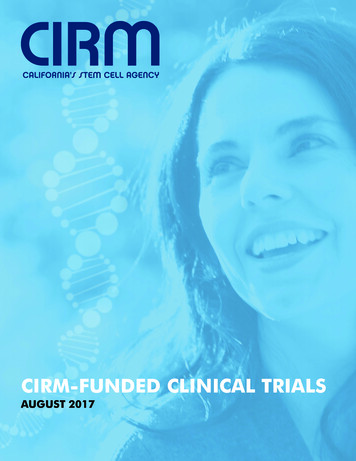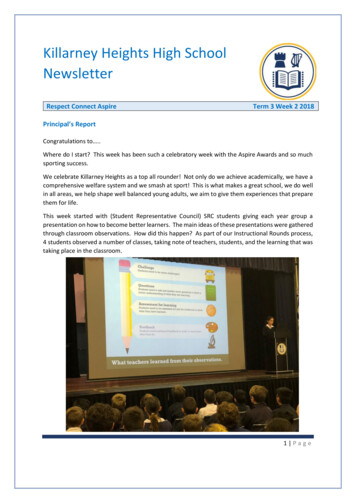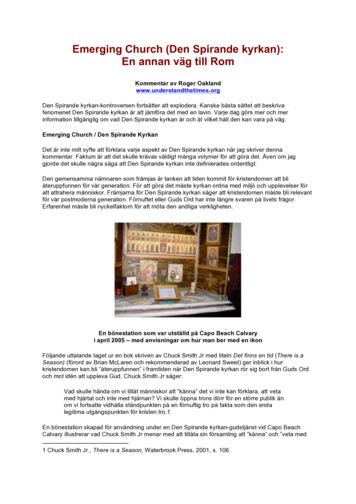
Transcription
CIRM-FUNDED CLINICAL TRIALSAUGUST 2017
AMYOTROPHIC LATERAL SCLEROSIS, ALS (2 projects)(Also known as Lou Gehrig’s disease)Cedars-Sinai Medical CenterPrincipal Investigator: Clive SvendsenA team at Cedars-Sinai is transplanting millions of genetically engineered stemcells into patients with a degenerative nerve disease called ALS. When transplanted, these cells become astrocytes, the support cells that keep nerve cells functioning. Due to the genetic modifications, the cells also deliver high doses of a growthfactor which has been shown to protect nerve cells. The goal of this early stagetrial is to test the safety of this astrocyte replacement strategy in ALS patients.BrainStorm Cell TherapeuticsPrincipal Investigator: Ralph KernBrainStorm Therapeutics is using mesenchymal stem cells that are taken from thepatient’s own bone marrow. These stem cells are then modified to boost theirproduction of neurotrophic factors, which are known to help support and protectneurons, the cells destroyed by ALS. The CIRM funding will enable the company totest this therapy, called NurOwn , in a Phase 3 trial involving about 200 patients.ALPHA THALASSEMIA MAJORUC San FranciscoPrincipal Investigator: Tippi MacKenzieDr. MacKenzie is using hematopoietic stem cells (HSCs) to treat babies in thewomb who have alpha thalassemia major, a blood disorder that is almost alwaysfatal. The HSCs are taken from the mother’s bone marrow and transplanted intothe baby before birth. The mother’s cells are able to survive and correct the defectin the baby’s blood cells, increasing the chances of a healthy birth and improvingthe chances of having effective treatments after birth.CANCER (5 projects)Blood CancersAngiocrine BiosciencesPrincipal Investigator: Paul FinneganThe Angiocrine team is developing a cell therapy aimed to improve the availabilityand engraftment of blood stem cell transplants for cancer patients who have hadtheir cancerous bone marrow removed by chemotherapy. The cell therapy is madeof blood stem cells and endothelial cells, which line blood vessels and are thoughtto improve the engraftment of the stem cell transplant. The hope is that this treatment will provide a safer, more tolerable and effective stem cell transplantationthat will rebuild the patient’s immune system cancer-free.LeukemiaUC San Diego (2 projects)Principal Investigator: Thomas KippsA team at UCSD is testing an antibody therapy called cirmtuzumab in a clincal trialOur Mission: To accelerate stem cell treatments to patients with unmet medical needs.1
CANCER - Continuedstudy to treat a blood cancer, Chronic Lymphocytic Leukemia (CLL). The antibodyrecognizes and attaches to a protein on the surface of cancer stem cells. Thisattachment disables the protein which slows the growth of the leukemia and makesit more vulnerable to anti-cancer drugs. The team is also testing cirmtuzumab incombination with an approved cancer fighting drug called ibrutinib, to target cancer stem cells in a separate clinical trial. The aim is that combining cirmtuzumabwith ibrutinib will improve cancer remission and long-term cancer control in patients.Skin Cancer, Synovial Sarcoma and other cancersUCLAPrincipal Investigator: Antoni RibasThere are few options for patients whose cancers have metastasized, or spread,due to resistance to current therapies. This team is using gene editing technologyto modify a patient’s own immune system cells and blood-forming stem cells withthe aim of creating a continuous supply of immune cells that can recognize andattack hard-to-treat cancers.Solid TumorsUCLAPrincipal Investigator: Dennis SlamonA team at UCLA is testing a drug for the treatment of cancer that works by blocking PLK4, a protein that is important in regulating cell growth, division and death.This protein is important for the survival of the cancer stem cell as well as the restof the cells in a tumor. It is hypothesized that blocking this protein from working inin the tumor may stop or even shrink tumor growth.Solid Tumors/Colorectal CancerForty Seven, Inc.Principal Investigator: Mark ChaoForty Seven, Inc. has developed an antibody therapy to block a protein calledCD47 that is found on the surface of cancer cells. CD47 acts as a ‘don’t eat me’signal that tells immune cells not to eliminate the cancer cells. When this ‘don’teat me’ signal is blocked by the antibody, the cancer cells are ‘eaten’ and eliminated by the patient’s immune cells . Forty Seven, Inc. will combine the anti-CD47antibody with cetuximab – a drug used in the treatment of solid tumors – to treatpatients with advanced colorectal cancer, hitting it with a 1-2 punch to kill thetumors and prevent any recurrence.CHRONIC GRANULOMATOUS DISEASEUCLAPrincipal Investigator: Donald KohnChronic granulomatous disease is a rare immune disorder that results in severe,recurrent infections that can impact quality and length of life. A team at UCLA usesOur Mission: To accelerate stem cell treatments to patients with unmet medical needs.2
CHRONIC GRANULOMATOUS DISEASE - Continuedthe patient’s own genetically modified blood stem cells to create a new blood supply and a healthy immune system, with the aim of curing patients with this disease.DIABETES (2 projects)ViaCyte, Inc.Principal Investigator: Howard FoytViaCyte is developing a cell therapy to replace lost beta cells for people with type1 diabetes. The therapy is derived from human embryonic stem cells which arepartially matured into becoming pancreatic tissues (the type destroyed in type1 diabetes). The cells are inserted into a small pouch that blood vessels can penetrate.The aim of the therapy is that by transplanting the pouch into the patient, the cellswill develop into fully matured beta cells that secrete the hormone insulin, which isneeded to keep blood sugar levels at a healthy level.Caladrius BiosciencesPrincipal Investigator: Douglas LosordoResearchers at Caladrius Biosciences will take cells, called regulatory T cells(Tregs), from the patient’s own immune system, expand the number of those cellsin the lab and return them to the patient to reduce the autoimmune attack on theinsulin-producing cells in people with type 1diabetes.HEART DISEASEDuchenne Muscular Dystrophy-Associated Heart DiseaseCapricor TherapeuticsPrincipal Investigator: Deborah AscheimCapricor is using donor cells derived from the heart to treat patients suffering fromDuchenne Muscular Dystrophy (DMD), a genetic disorder that leads to progressive muscle degeneration, including heart muscle. One of the leading causes ofdeath for children with DMD is heart failure and the aim of this treatment is to helpimprove heart muscle outcomes for these patients.HIV/AIDS (3 projects)Calimmune, Inc.Principal Investigator: Geoff SymondsCalimmune is genetically modifying patients’ own blood-forming stem cells (alsoknown as bone marrow stem cells) so they can produce immune cells—the onesnormally destroyed by the virus—that cannot be infected by the virus. The goal ofthis treatment is enable the patients to clear their systems of the virus, effectivelycuring the disease.City of Hope and Sangamo TherapeuticsPrincipal Investigator: John ZaiaA team at City of Hope and Sangamo Therapeutics is testing a similar method tofunctionally cure people with HIV. But while Calimmune is using a technique calledOur Mission: To accelerate stem cell treatments to patients with unmet medical needs.3
HIV/AIDS - ContinuedRNA interference to block the virus, City of Hope/Sangamo are using a technologycalled zinc finger nuclease – a kind of molecular scissors – to snip out the targetgene.AIDS-related lymphomaUC DavisPrincipal Investigator: Mehrdad AbediA team at UC Davis is taking a patient’s blood forming stem cells and insertingthree anti-HIV genes into them and then returning them to the individual to helprebuild their immune system. The anti-HIV genes are then passed on to all newimmune system cells and make them resistant to HIV. Because AIDS-related lymphoma is linked to the constant immune cell stimulation caused by HIV infection,getting rid of the virus should prevent return of the cancer.KIDNEY DISEASE (2 projects)Kidney FailureStanford UniversityPrincipal Investigator: Samuel StroberA team at Stanford University will work with kidney transplant patients to see ifinjecting blood stem cells and T cells (which play an important role in the immunesystem) from the kidney donor into the kidney recipient can enable the recipient tobypass the need for a life-long dependence on immunosuppressant drugs.DialysisHumacyte, Inc.Principal Investigator: Jeffrey LawsonHumacyte is using donor cells to create a bioengineered vein needed by peopleundergoing hemodialysis, the most common form of dialysis. In dialysis a person isconnected to a machine that removes waste from their blood. The bioengineeredvein is implanted in the arm and used to carry the patient’s blood to and from theirbody during dialysis. Over time the patient’s own stem cells start to populate thisvein, in effect making it part of the patient’s own body.MACULAR DEGENERATIONUniversity of Southern CaliforniaPrincipal Investigator: Mark HumayunRegenerative Patch Technologies and scientists at the University of Southern California and UC Santa Barbara, are growing specialized cells of the retina fromembryonic stem cells, placing them on a single layer scaffold and implanting thecombination device in the back of the eye to try to reverse blindness.Our Mission: To accelerate stem cell treatments to patients with unmet medical needs.4
OSTEONECROSISUC DavisPrincipal Investigator: Nancy LaneA team at UC Davis is testing a drug that directs bone stem cells to the surface ofthe bone where they then develop new bone tissue and stimulate new blood vesselformation, two defects underlying osteonecrosis. Should this drug prove safe andand show signs of effectiveness, it may be tested for the treatment of other bonediseases like osteoporosis.PULMONARY HYPERTENSIONCedars-Sinai Medical CenterPrincipal Investigator: Michael LewisA team at Cedars-Sinai Medical Center is using donor cells derived from the heartto reduce two hallmark symptoms of pulmonary hypertension: inflammation andhigh blood pressure in the blood vessels within the lungs. These conditions makethe heart struggle to pump blood to the lungs and over time can ultimately lead toheart failure. The aim of this treatment is to delay the progression of the disease.RETINITIS PIGMENTOSA (2 projects)UC Irvine and jCyte, Inc.Principal Investigator: Henry KlassenA team at UC Irvine, is using cells called retinal progenitor cells to repair the damage caused by this vision destroying disease. The cells are injected into the backof the eye and it’s hoped they will help preserve the photoreceptors attacked by RPas well as generate new photo receptors to replace those destroyed by the disease.We funded the Phase 1 clinical trial and are now funding Phase 2.SEVERE COMBINED IMMUNODEFICIENCY (SCID) (3 PROJECTS)UCLAPrincipal Investigator: Donald KohnA team at UCLA is using a patient’s own blood stem cells to try and repair theirdamaged immune system. They will use what’s called a lentiviral vector to delivergenetic material into the blood stem cells, correcting the genetic flaw that causesSCID. It’s hoped this will create a new blood system and a healthy immune system.Stanford UniversityPrincipal Investigator: Judith ShizuruA team at Stanford proposes to replace SCID patients’ dysfunctional immune cellswith healthy ones using a safer form of bone marrow transplant (BMT). CurrentBMT procedures must use toxic chemotherapy to make space in the bone marrowfor the healthy transplanted stem cells to engraft. The Stanford team will insteadtest a safe, non-toxic protein that targets and removes the defective blood formingstem cells. If successful, the procedure could open up similar BMT therapies to patients with other auto-immune diseases such as multiple sclerosis, lupus or diabetesthat are generally not candidates for BMT currently.Our Mission: To accelerate stem cell treatments to patients with unmet medical needs.5
SEVERE COMBINED IMMUNODEFICIENCY (SCID) - ContinuedSt. Jude Children’s Research HospitalPrincipal Investigator: Brian SorrentinoSt. Jude Children’s Research Hospital is teaming up with UC San Francisco to repair the damaged immune system of children born with SCID. They will geneticallymodify the patient’s own blood stem cells, with the goal of creating a new bloodsystem and restoring the health of the immune system.SICKLE CELL ANEMIAUCLAPrincipal Investigator: Donald KohnA team at UCLA is genetically modifying a patient’s own blood stem cells to produce a correct version of hemoglobin, the protein that is mutated in these patients,which causes abnormal sickle-like shaped red blood cells. These misshapen cellslead to dangerous blood clots, debilitating pain and even death. The geneticallymodified stem cells will be given back to the patient to create a new sickle cell-freeblood supply.SPINAL CORD INJURYAsterias BiotherapeuticsPrincipal Investigator: Jane LebkowskiAsterias Biotherapeutics uses cells derived from embryonic stem cells to heal thespinal cord at the site of injury. They mature the stem cells into cells called oligodendrocyte precursor cells that are injected at the site of injury where it is hopedthey can repair the insulating layer, called myelin, that normally protects the nervesin the spinal cord.STROKESanBioPrincipal Investigator: Damien BatesSanBio is carrying out a Phase 2 clinical trial using mesenchymal stem cells (MSCs)to help people suffering from chronic disability following a stroke. The MSCs areisolated from the bone marrow of healthy adult donors, and then modified to enhance their ability to promote recovery from injury by triggering the brain’s naturalregenerative ability. Patients with stroke can suffer from loss of mobility in certainparts of their body and the hope is that this therapy will rescue some of these problems.Our Mission: To accelerate stem cell treatments to patients with unmet medical needs.6
CLOSED CLINICAL TRIALSCANCERBrain Cancer (Glioblastoma)ImmunoCellular Therapeutics is targeting six proteins that are found on the surfaceof cancer stem cells in glioblastoma, a brain cancer. Immune cells from the patient’s own immune system are exposed to fragments of these cancer cell proteinsin the lab. When returned to the patient’s body, these immune system cells cannow help the patient’s immune system identify, and then hopefully kill, the cancerstem cells responsible for the tumor’s recurrence and growth. This Phase 3 trialwas suspended in June 2017 due to lack of sufficient financial resources.Metastatic Skin Cancer (Melanoma)NeoStem, which later changed its name to Caladrius BioScience, ran a Phase3 trial targeting cancer stem cells. These cells are believed to be able to survivechemotherapy and other cancer-targeting treatments, and can cause a relapse byenabling tumors to grow and spread. This approach used the patient’s own tumorcells to create a personalized therapy, one designed to engage the patient’s ownimmune system and destroy the cancer. The trial was halted by Caladrius in January 2016 for business reasons.Solid Tumors/Acute myeloid leukemiaA team at Stanford University is using a molecule known as an antibody to targetcancer stem cells. This antibody can recognize CD47, a protein the cancer stemcells carry on their cell surface. The cancer cells use that protein to evade thecomponent of our immune system that routinely destroys tumors. By disabling thisprotein, the team hopes to empower the body’s own immune system to attack anddestroy the cancer stem cells. The clinical trial testing this therapy has concludedand has led to another CIRM-funded trial by Forty-Seven, Inc.HEART FAILUREIn this trial, Capricor Therapeutics used donor cells derived from the heart to treatpatients at risk for developing heart failure after a heart attack. In previous clinicalstudies, the cells appear to reduce scar tissue, promote blood vessel growth andimprove heart function. This trial is ending after failing to achieve its primary goal ofreduction of scar size in the heart.HUNTINGTON’S DISEASE (observational)A team at UC Davis plans to use bone marrow derived mesenchymal stem cells todeliver a growth factor, called BDNF, to patients’ brains in order to reduce the deathof nerve cells that occurs in Huntington’s Disease (HD). In preparation for such aclinical trial study, the team completed a CIRM-funded observational trial in a groupof HD patients to study the progression of disease.Our Mission: To accelerate stem cell treatments to patients with unmet medical needs.7
SPINAL CORD INJURYGeron carried out a Phase 1 clinical trial to assess the safety and preliminary activityof escalating doses of human embryonic stem cell (hESC) derived oligodendrocyteprogenitor cells for treatment of spinal cord injury. Five patients were treated, allsafely and without any serious side effects, before the trial was halted by Geron forfinancial reasons. The work in this trial later has since been revived by Asterias.Our Mission: To accelerate stem cell treatments to patients with unmet medical needs.8
UC Davis Principal Investigator: Mehrdad Abedi A team at UC Davis is taking a patient's blood forming stem cells and inserting three anti-HIV genes into them and then returning them to the individual to help rebuild their immune system. The anti-HIV genes are then passed on to all new immune system cells and make them resistant to HIV.











